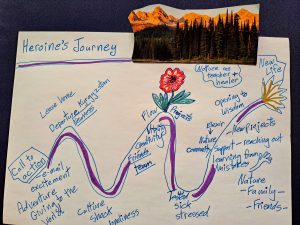8 Exploring Life Transitions Through the Story Cycle
“A hero is an ordinary individual who finds the strength to persevere and endure in spite of overwhelming obstacles.” Christopher Reeve
Purpose:
Participants will reflect on where they are in the human life cycle and how they have coped with transitions.
Learning Objectives
Participants will
- Reflect on transitions they have experienced.
- Recognize that transitions are part of the life journey and that there can be different emotions and strategies for coping with changes.
- Deepen relationships with peers while sharing challenges and insights about adapting to life’s transitions.
Activity Instructions
- Class Discussion: What are the major transitions that people might experience in the human life cycle? (Have a participant write the responses on the whiteboard). Stages of life can include: conception, birth, crawling, walking, kindergarten, puberty, drivers licence, high school graduation, leaving home to start job or college, love, marriage, children, death of parents or other loved ones, health issues, own death.
Follow-Up Questions:
- Where are you in this cycle right now?
- How are stages of life marked or celebrated in your culture?
- Are there any aspects of this life cycle that are different or changing for your generation compared to that of your parents or grandparents?
- What are some of the emotions you experienced during a recent transition?
- What helped you through your period of transition?
2. Watch the Ted-Ed video What Makes a Hero (based on Joseph Campbell mythic theory, 4 min)
3. Panel Discussion: Conduct a small panel interview with three people from different cultures and stages of life who are part of the group or guests who can speak to different life transitions.
Moderator/Facilitator questions:
- What resonated with you from this short video that compares our life journey with those in fiction or movies?
- What is the most recent life transition you have experienced?
- What helped you get through those experiences?
- What do you know about yourself that soothes you if you are feeling overwhelmed or homesick or having difficulties adjusting to a new stage of life?
- How are these life transitions the same or different in other cultures?
- Do you have any suggestions that might help someone navigating a challenging transition?
Ask the audience about what impacted them from the stories of these panelists. How do their stories of managing transitions resonate with the listeners?
4. Personal Map Making: Ask each participant to create a map showing their personal Hero’s Quest. What ups and downs, mentors and allies and important experiences have led to this very moment? (30 minutes drawing time, music playing, various art materials for map.)You could also make the assignment more specific by asking them to map one particular challenge that went through this quest cycle.
5. Small Group Discussion: Form groups of four and encourage each person to share the highlights of their map. Listeners can ask questions and comment on the strengths and values that have shaped the speaker’s life journey.
6. Whole Group Discussion: What did you learn about yourself as you reflected on your life journey and transitions you have experienced? What was something you learned about your group members during this discussion? Are there differences between cultures or demographic groups in how they view transitions? What kinds of rituals or ceremonies mark transitions in your family or culture?
Adaptations for On-Line Learning:
This workshop works well on-line. It is possible to show the video as part of one online class and have them draw their “Personal Map” on their own time and bring it to the following class to share in break-out rooms.
For English as a second language groups:
Discuss and define the following vocabulary and idioms before watching the video:
Transition, Status Quo, Myth, Regret, Ordeal, Fitting In, Resolution, Conquer your Fear, Comfort Zone, Quest, “In the deepest cave of your fear, lies the treasure you seek.”
Resources Needed:
- Video: What Makes a Hero.
- White board markers
- Art Materials (poster paper, coloured markers, pastels, collage materials)
- Tables for art making and break out discussions
- This graphic could be used to help participants identify the stages before they create the specific details of their mythic journeys.
Pat Butler’s blog post “Explanation and Exploration of the Hero’s Journey” provides more information about this mythic process: Pat Butler Hero’s Journey
Example of a personal journey map leaving the ordinary world and going through ordeals that promote growth, resilience and new levels of wisdom:

